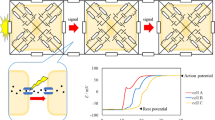Abstract
In the functional electrical stimulation of nerve an expression defined as the ‘activating function’ has been introduced to evaluate the propensity for a particular fibre to excite. This approach to determine resulting activation is only an approximation as it neglects the presence of the fibres on the applied field, in contrast to activity determined from a rigorous solution to the core conductor/excitable membrane equations. An alternative approach to determining relative excitability based on the induced transmembrane potential is presented, thereby allowing for current redistribution via the space constant of the target fibre. The paper critically examines the approximations made with activating functions, and concludes that as currently formulated the activating function has limitations in predicting relative excitability under a number of important conditions. In contrast, it is the induced (passive) transmembrane potential that provides a quantitatively reliable estimate of the tendency for fibres to excite.
Similar content being viewed by others
References
Altman, K. W. andPlonsey, R. (1986) A two-part model for determining the electromagnetic and physiologic behavior of cuff electrode nerve stimulators.IEEE Trans.,BME-33, 285–293.
Altman, K. W. andPlonsey, R. (1988) Development of a model for point source electrical fibre bundle stimulation.Med. & Biol. Eng. & Comput.,26, 466–475.
Altman, K. W. andPlonsey, R. (1989) Analysis of the longitudinal and radial resistivity measurements of the nerve trunk.Ann. Biomed. Eng.,17, 313–324.
Altman, K. W. andPlonsey, R. (1990) Point source nerve bundle stimulation: effects of fibre diameter and depth on simulated excitation.IEEE Trans.,BME-37, (in press).
Andrietti, F. andBernardini, G. (1984) Segmented and ‘equivalent’ representation of the cable equation.Biophys. J.,46, 615–623.
Blair, E. A. andErlanger, J. (1933) A comparison of the characteristics of axons through their individual electrical responses.Am. J. Physiol.,106, 524–564.
Chiu, S. Y., Ritchie, J. M., Rogart, R. B. andStagg, D. (1979) A quantitative description of membrane currents in rabbit myelinated nerve.J. Physiol.,292, 149–166.
Coburn, B. (1989) Neural modeling in electrical stimulation.Crit. Rev. in Biomed. Eng.,17, 133–178.
Dodge, F. A. andFrankenhauser, B. (1959) Sodium currents in myelinated nerve.J. Physiol. (London),148, 188–200.
Frankenhauser, B. andHuxley, A. F. (1964) The action potential in the myelinated nerve fibre ofXenopus laevis as computed on the basis of voltage clamp data.,171, 302–315.
McNeal, D. R. (1976) Analysis of a model for excitation of myelinated nerve.IEEE Trans.,BME-23, 329–337.
Plonsey, R. andAltman, K. W. (1988) Electrical stimulation of excitable cells—a model approach.Proc. IEEE,76, 1122–1129.
Ranck, J. B. (1975) Which elements are excited in electrical stimulation of mammalian central nervous system: a review.Brain Res.,98, 417–440.
Rattay, F. (1986) Analysis of models for external stimulation of axons.IEEE Trans.,BME-33, 974–977.
Rattay, F. (1987) Ways to approximate current-distance relations for electrically stimulated fibres.J. Theor. Biol.,125, 339–349.
Rattay, F. (1989) Analysis of models for extracellular fiber stimulation.IEEE Trans.,BME-36, 676–682.
Rubinstein, J. T. andSpelman, F. A. (1988) Analytical theory for extracellular electrical stimulation of nerve with focal electrodes; I. Passive unmyelinated fibre,Biophys. J.,54, 975–981.
Stein, R. B. (1980)Nerve and muscle: membranes, cells, and systems. Plenum Press, New York.
Tasaki, I. (1964) A new measurement of action currents developed by single nodes of Ranvier.J. Neurophysiol.,27, 1199–1206.
Tranchina, D. andNicholson, C. (1986) A model for the polarization of neurons by extrinsically applied electric fields.Biophys. J.,50, 1139–1156.
Weidman, S. (1952) The electrical constants ofPurkinje fibres.J. Physiol.,118, 348–360.
Author information
Authors and Affiliations
Rights and permissions
About this article
Cite this article
Altman, K.W., Plonsey, R. Analysis of excitable cell activation: relative effects of external electrical stimuli. Med. Biol. Eng. Comput. 28, 574–580 (1990). https://doi.org/10.1007/BF02442610
Received:
Accepted:
Issue Date:
DOI: https://doi.org/10.1007/BF02442610




